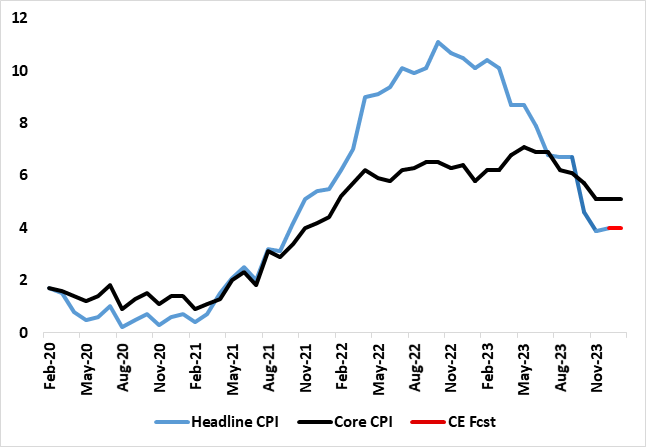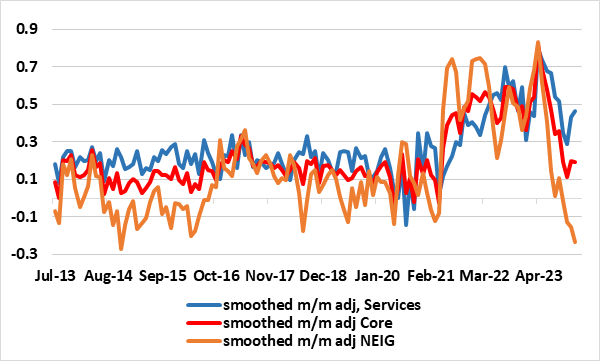UK CPI Inflation Preview (Feb 14): Headline and Core to Fail to Fall Again?

With both upside and downside surprises, UK headline and core inflation have been on a clear downward trajectory in the last few months the former having peaked above 10% in February and the latter at 7.1% In May. However, this trend surprisingly stalled in December as the headline rate rose a notch to 4.0%, up from a 27-month low of 3.9%, the first rise in 10 months (Figure 1) and where the core rate remained at 5.1%, still a 23-month low. We see both the headline and core begun unchanged in the January data with services inflation boosted by adverse base effects around airfares but this being offset by lower food and non-energy goods price pressures (developments that chime with BRC survey numbers) as well as further falls in petrol prices.
Figure 1: Headline and Core Inflation Drop Stalls Again

Source: ONS, Continuum Economics
The December data came alongside clearly soft PPI data at least for manufacturing but where services PPI edged up to 3.6%. The headline rate was still some 0.6% ppt below formal BoE thinking at the time but is clearly a disappointment, not least as half of the 12 main components saw a fresh pick-up and where our estimate of the seasonally adjusted data (Figure 2) saw something of a reversal of the hitherto clear disinflation trend seen in previous months. We see the adjusted core moving sideways too in January!
The CPI data are perturbing for the BoE hawks and hence their demand to see more data to assess how sizeable and durable the current disinflation process actually is. But despite official labor market revisions showing higher inactivity, the numbers still show wages data softness which the BoE majority should view in tempering its worries about persistent price pressures, especially if also presented on such an adjusted m/m basis.
The government has made much of the fact that CPI inflation slowed to 4.6% y/y in October 2023, down from 6.7% in September and thus has more than halved from its peak of over 11% a year ago. The drop has little to do with government action, the very opposite. Instead, both supply (we think predominantly) and demand (to a lesser extent) factors are reining in price and cost pressures and more broadly so. Indeed, the recent rise in tobacco duty very much contributed to the surprise rise in the headline rate in December
As for those latest numbers, CPI inflation rose by 4.0% in the 12 months to December 2023, up from 3.9% in November, and the first time the rate has increased since February 2023. On a monthly basis, CPI rose by 0.4% in December 2023, the same rate as in December 2022. The largest upward contribution to the monthly change in CPI annual rates came from alcohol and tobacco while the largest downward contribution came from food and non-alcoholic beverages. Core CPI (excluding energy, food, alcohol and tobacco) rose by 5.1% in the 12 months to December 2023, the same rate as in November; the CPI goods annual rate slowed from 2.0% to 1.9%, while the CPI services annual rate increased from 6.3% to 6.4%.
Figure 2: Adjusted Core CPI Pressures No Longer Falling But Consistent With BoE Target?

Source: ONS, Continuum Economics, smoothed is 3 mth mov avg
All of this is likely to have perturbed the BoE, albeit still calmed by as various alternative y/y measures of core and underlying inflation have started to fall and where seasonally adjusted core prices have eased further. However, recent months suggest that this slowing in core adjusted inflation has not intensified, instead with recent underlying inflation remaining close to target on a smoothed m/m adjusted basis. But headline inflation has been running near zero on this adjusted basis helped by a marked fall in non-energy goods inflation (Figure 2), this also having helped offset somewhat resilient services in pulling the core down too.
How Low Can Headline CPI Get?
We still see disinflation continuing and note that base effects swing favourably as from February, particularly for hitherto resilient services, all pointing to the headline rate falling afresh and appreciably. We see the rate below target in Q2, after hefty fall in advance during Feb/Mar. Indeed the rate may move towards 1.5% for some part of Q2 but then moving back to around or just above target in H2. The BoE is not quite as confident and instead envisages any slowing in coming months as unlikely to persist with the headline moving back towards 3%, the question why it believes an inflation drop largely a result of ebbing supply prices should mean persistent price pressures continue.
Regardless, it may be that (apparently ebbing) economy risks are now taking precedence for the MPC majority but where some on the MPC want to see evidence that wage inflation is abating and this does seem to be forthcoming. We still see BoE rate cuts starting before mid-year.